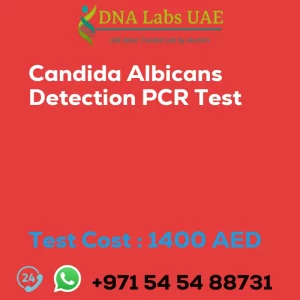Salmonella Typhi Bacterial Load Test
Cost: AED 1360.0
Test Name: Salmonella Typhi Bacterial Load Test
Components: Whole Blood, rectal swabs, food samples, water sample
Price: 1360.0 AED
Sample Condition: Whole Blood, rectal swabs, food samples, water sample
Report Delivery: 3rd Working Day Email: 36 hours, On phone: 24 hours
Method: Real Time PCR
Test Type: Viral
Doctor: Physician
Test Department: Genetics
Pre Test Information: Need to sign Consent document and bring any clinical history of patient for Salmonella Typhi Bacterial Load Test
Test Details
The Salmonella Typhi bacterial load test is a diagnostic test used to determine the quantity or concentration of Salmonella Typhi bacteria in a sample. Salmonella Typhi is the bacterium responsible for causing typhoid fever, a potentially serious and life-threatening infection. The test is typically performed on blood, stool, or urine samples, as these are common sources of Salmonella Typhi infection.
The bacterial load test can be useful in diagnosing typhoid fever and monitoring the progression of the infection. There are several methods used to determine the bacterial load of Salmonella Typhi. These include:
- Culture-based methods: This involves isolating the bacteria from the sample and growing them on specific media. The number of bacterial colonies that grow on the culture plates can indicate the bacterial load.
- Polymerase chain reaction (PCR): This molecular technique amplifies the DNA of Salmonella Typhi in the sample, allowing for the detection and quantification of the bacteria.
- Serological tests: These tests detect the presence of antibodies produced by the body in response to Salmonella Typhi infection. The concentration of antibodies can provide an indirect measure of the bacterial load.
The bacterial load test is important for diagnosing typhoid fever and determining the severity of the infection. It can also help monitor the effectiveness of treatment and guide decisions regarding patient management. It is important to note that the bacterial load test is typically performed in a laboratory setting by trained professionals. The results of the test should be interpreted by a healthcare provider who can take into account the clinical symptoms and other relevant factors to make an accurate diagnosis.
| Test Name | Salmonella Typhi Bacterial Load Test |
|---|---|
| Components | |
| Price | 1360.0 AED |
| Sample Condition | Whole Blood, rectal swabs, food samples, water sample |
| Report Delivery | 3rd Working Day Email:-36 hours.On phone: 24 hours |
| Method | Real Time PCR |
| Test type | Viral |
| Doctor | Physician |
| Test Department: | Genetics |
| Pre Test Information | Need to sign Consent document and bring any clinical history of patient forSalmonella Typhi Bacterial LoadTest |
| Test Details |
The Salmonella Typhi bacterial load test is a diagnostic test used to determine the quantity or concentration of Salmonella Typhi bacteria in a sample. Salmonella Typhi is the bacterium responsible for causing typhoid fever, a potentially serious and life-threatening infection. The test is typically performed on blood, stool, or urine samples, as these are common sources of Salmonella Typhi infection. The bacterial load test can be useful in diagnosing typhoid fever and monitoring the progression of the infection. There are several methods used to determine the bacterial load of Salmonella Typhi. These include: 1. Culture-based methods: This involves isolating the bacteria from the sample and growing them on specific media. The number of bacterial colonies that grow on the culture plates can indicate the bacterial load. 2. Polymerase chain reaction (PCR): This molecular technique amplifies the DNA of Salmonella Typhi in the sample, allowing for the detection and quantification of the bacteria. 3. Serological tests: These tests detect the presence of antibodies produced by the body in response to Salmonella Typhi infection. The concentration of antibodies can provide an indirect measure of the bacterial load. The bacterial load test is important for diagnosing typhoid fever and determining the severity of the infection. It can also help monitor the effectiveness of treatment and guide decisions regarding patient management. It is important to note that the bacterial load test is typically performed in a laboratory setting by trained professionals. The results of the test should be interpreted by a healthcare provider who can take into account the clinical symptoms and other relevant factors to make an accurate diagnosis. |







